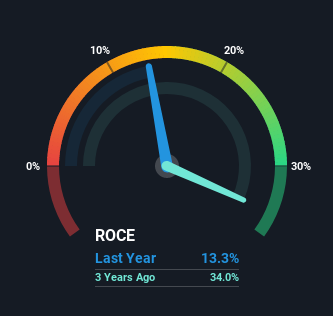Blue Bird (NASDAQ:BLBD) May Have Issues Allocating Its Capital
If we want to find a stock that could multiply over the long term, what are the underlying trends we should look for? Firstly, we'll want to see a proven return on capital employed (ROCE) that is increasing, and secondly, an expanding base of capital employed. If you see this, it typically means it's a company with a great business model and plenty of profitable reinvestment opportunities. In light of that, when we looked at Blue Bird (NASDAQ:BLBD) and its ROCE trend, we weren't exactly thrilled.
Return On Capital Employed (ROCE): What is it?
For those that aren't sure what ROCE is, it measures the amount of pre-tax profits a company can generate from the capital employed in its business. The formula for this calculation on Blue Bird is:
Return on Capital Employed = Earnings Before Interest and Tax (EBIT) ÷ (Total Assets - Current Liabilities)
0.13 = US$26m ÷ (US$308m - US$109m) (Based on the trailing twelve months to January 2021).
So, Blue Bird has an ROCE of 13%. On its own, that's a standard return, however it's much better than the 9.9% generated by the Machinery industry.
Check out our latest analysis for Blue Bird
In the above chart we have measured Blue Bird's prior ROCE against its prior performance, but the future is arguably more important. If you're interested, you can view the analysts predictions in our free report on analyst forecasts for the company.
What Can We Tell From Blue Bird's ROCE Trend?
In terms of Blue Bird's historical ROCE movements, the trend isn't fantastic. Over the last five years, returns on capital have decreased to 13% from 34% five years ago. Given the business is employing more capital while revenue has slipped, this is a bit concerning. This could mean that the business is losing its competitive advantage or market share, because while more money is being put into ventures, it's actually producing a lower return - "less bang for their buck" per se.
Our Take On Blue Bird's ROCE
From the above analysis, we find it rather worrisome that returns on capital and sales for Blue Bird have fallen, meanwhile the business is employing more capital than it was five years ago. Since the stock has skyrocketed 162% over the last five years, it looks like investors have high expectations of the stock. Regardless, we don't feel too comfortable with the fundamentals so we'd be steering clear of this stock for now.
If you'd like to know more about Blue Bird, we've spotted 5 warning signs, and 2 of them don't sit too well with us.
While Blue Bird isn't earning the highest return, check out this free list of companies that are earning high returns on equity with solid balance sheets.
This article by Simply Wall St is general in nature. It does not constitute a recommendation to buy or sell any stock, and does not take account of your objectives, or your financial situation. We aim to bring you long-term focused analysis driven by fundamental data. Note that our analysis may not factor in the latest price-sensitive company announcements or qualitative material. Simply Wall St has no position in any stocks mentioned.
Have feedback on this article? Concerned about the content? Get in touch with us directly. Alternatively, email editorial-team (at) simplywallst.com.

